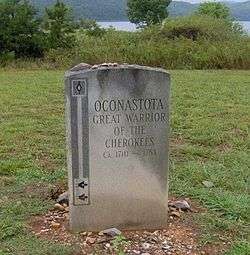Oconostota
Oconostota (ca. 1710-1783) (also "Stalking Turkey") was a skiagusta of Chota and the First Beloved Man of the Cherokee from 1775 to 1781.
Meaning of the name
His Cherokee name, according to Mooney, was "Aganstata," which he translated as "groundhog-sausage" (agana = groundhog, and tsistau = "I am pounding it"—as in pounding meat in a mortar). It appears as "Oconastota" (with two 'a's) on his grave marker at the site of Chota. Chota had been the chief town of Overhill Cherokee for a time.
Background
Oconostota may have been a son of Moytoy of Tellico, and was born around 1704, one of eleven children. The identity of Oconostota's first wife is a mystery, although she was of the Paint Clan. Their daughter, Nionne Ollie, married his cousin Attakullakulla, his predecessor as First Beloved Man. Some sources claim Nionne Ollie was a Natchez refugee who was adopted as the daughter of Oconostota's wife (as the Cherokee were a matrilineal society, inheritance and descent went through the mother's clan.)[1] Some Natchez or Natchers lived in the Upper South prior to relocating farther south.
Oconostota first appears in historical records in 1736. He was a prominent warrior among the Cherokee, and was called "The Great Warrior of Chota." He may have been influenced by the German utopian Christian Priber, who lived with the Cherokee from about 1735 to 1739. [2] He eventually transferred his allegiance from the French to the British, and in 1753 led a pro-British Cherokee force against the Choctaw. Over the next 12 years the Cherokee fought both with and against the British, but as more and more American settlers encroached on Cherokee land, the Cherokee threw their suopport behind the British. [3]
Oconostota became the First Beloved Man of the Cherokee following the death of his cousin Attakullakulla, sometime around 1775-1777. His tenure was fraught with warfare and struggle, which culminated in 1780 in the destruction of Chota and Tanasi by American revolutionary forces during the rebellion against the British and their alliles. Many histories state that Oconostota went to England in either 1730 or 1762, but he was not a member of either delegation. Oconostota was believed to have died in either 1782 or 1783. He was buried with his hands on his chest holding a broadsword pointing down his body.
Memorial

During the archaeological digs at the site of Chota prior to the Tellico Reservoir impoundment, the remains of Oconostota were found. They were identified by a pair of reading glasses which he owned which were buried with him. Oconostota's remains were re-interred at Chota in the portion raised by TVA (which includes the site of the council house). A gravestone now marks the site.
Notes
- ↑ Klink, Karl, and James Talman, ed. 'The Journal of Major John Norton (Toronto: Champlain Society, 1970), p.42
- ↑ Woodward, Grace Steele, "The Cherokees" (Norman: University of Oklahoma Press, 1963), p. 68
- ↑ Kelly, James C. , "Oconostota," (Journal of Cherokee Studies, Vol. III No. 4, Fall 1978) pp. 221-238
References
- Litton, Gaston L. "The Principal Chiefs of the Cherokee Nation", Chronicles of Oklahoma 15:3 (September 1937) 253-270. (accessed August 28, 2006).
- Mooney, James. Myths of the Cherokee, (1900, reprint 1995).
- Kelly, James C. "Oconostota", Journal of Cherokee Studies 3:4 (Fall 1978), 221-238.
External links
- "Oconastota". Cherokee Chief. Find a Grave. July 7, 2002. Retrieved Aug 18, 2011.
 "Oconostota". Appletons' Cyclopædia of American Biography. 1900.
"Oconostota". Appletons' Cyclopædia of American Biography. 1900.